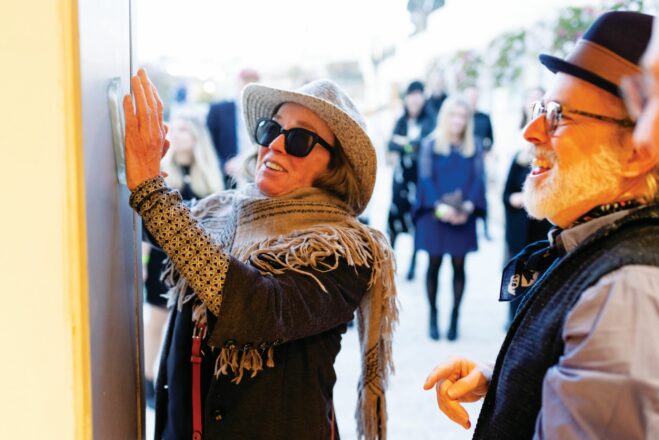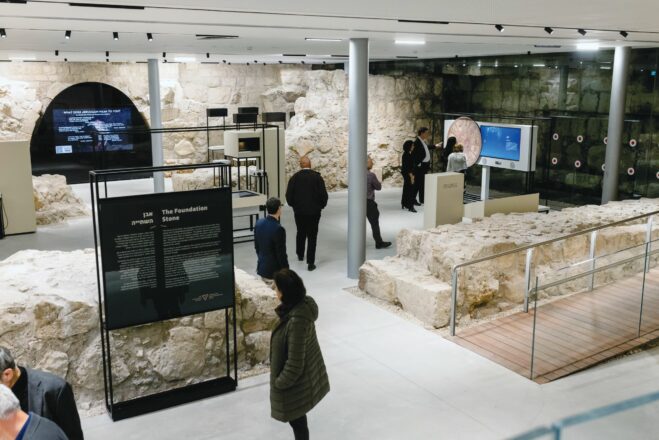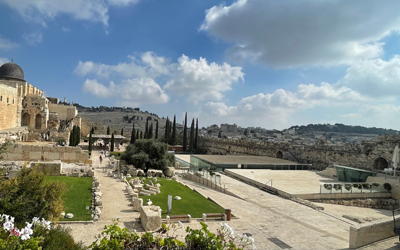Newly Renovated Davidson Center reopens in the Old City.

Israeli President Isaac Herzog, members of the Davidson Family and representatives from the Jewish Federation of Metro Detroit were on hand March 12 for the reopening of the Davidson Center in Jerusalem Archaeological Park after a three-year closure for renovations.
“The comprehensive renovation and establishment of this new center reveal to us the ancient, exciting and inspiring foundations of Jerusalem,” Herzog said. “And this story is mediated in an impressive manner, through new galleries, revolving exhibitions and an educational space for groups and activities.”

Karen Davidson, widow of William “Bill” Davidson z”l’ said the reopening was a “spectacular evening — just beautiful. President Herzog was able to articulate Bill’s vision for this space as a place that all Israelis, and tourists from around the world could experience and enjoy.”
Bill’s son, Ethan, who, as a traveling musician, had missed the original opening of the Davidson Center in 2001, spoke at the event. “When I stand here, the central thought that comes to my mind is this is something my father would have wanted — a historical place of great significance for the Jewish people.”

The newly renovated center is a worthy tribute to Davidson, a Detroit businessman and philanthropist whose legacy has been felt throughout Detroit and Israel.

“The Davidson Center offers visitors a unique experience exploring Jerusalem’s rich and varied history through its archaeological treasures,” said Darin McKeever, president and CEO of the William Davidson Foundation. “We believe that the museum will be an important cultural destination for both foreign and Israeli visitors, and we look forward to sharing the stories and discoveries from Jerusalem’s past with this large and diverse audience.”
According to Karen, “The crowd was a cross section of Israeli society, pretty special,” she said. “The whole evening was so well executed. Bill would have just been thrilled by it.”
The Davidson Center
The Jerusalem Archaeological Park was established in 1995 through the support of Davidson, who believed deeply in preserving the history of the Jewish people.

During the excavations in the park, remains of structures were discovered from the early Islamic period (the seventh and eighth centuries CE) and from the Roman and Byzantine periods (first-seventh centuries CE) and a few remains from the Hellenistic and earlier periods (eighth-second centuries BCE).
The Davidson Center first opened in 2001 and quickly became one of Jerusalem’s most innovative and technologically advanced tourist attractions. The Center displays finds from excavations throughout Israel that help tell the story of Jerusalem, particularly during the Second Temple period.
In order to keep a low profile within the park, most of the Davidson Center is located underground in some of the ancient storerooms from the Umayyad period (661-750 CE).
The building is across from the southwestern corner of the Temple Mount, along what archaeologists believe was a main street for pilgrims who were ascending to the Temple courtyards via the Hulda Gates during festivals or other occasions.
Renovation Process
The Davidson Center renovation project, which included a building expansion and full content refresh, was led by the Israel Antiquities Authority with funding provided by the William Davidson Foundation.

According to McKeever, the refresh and expansion has been in the works since 2012, when the Foundation provided funding to construct a new wing for the Davidson Center, home now to the Karen W. Davidson Gallery, which features a variety of interactive exhibits. Like the original Davidson Center, the new wing was designed by the world-renowned Israeli architect Etan Kimmel. The additional gallery expanded the Davidson Center footprint by approximately 40%.
As the expansion proceeded, the Foundation, in 2019, made a grant to refresh the entire center, filling the new wing and updating the original exhibits. The Israel Antiquities Authority selected Israeli design firm Breeze Creative to do the exhibits.

During renovations, the Center was closed for three years while experts from the Israel Antiquities Authority and The Company for the Reconstruction and Development of the Jewish Quarter oversaw the curation of the new exhibits.
McKeever said the crews worked throughout the pandemic closures, and that the lack of traffic in the Old City actually allowed them to speed up some of their work. The renovation also added new outdoor lighting in the Archaeological Park so the center will be able to stay open in the evenings as well as a café outside the park’s entrance, where visitors can stop and have a cup of coffee.
The Exhibits
Those on hand at the Davidson Center’s reopening were able to explore the theme of the Temple City of Jerusalem through a unique combination of ancient archaeological finds, innovative technology, artistic depictions and interactive galleries.
The Davidson Center features several ancient artifacts dating back to the First Temple Period 3,000 years ago. The exhibits at the entrance to the new Davidson Center focus on the name “Jerusalem,” and include some of the earliest-known inscriptions bearing Jerusalem’s ancient Hebrew name, “yršlm.”

Visitors can experience an entire gallery dedicated to the story of the origin of the Temple Menorah, a seven-branched candelabra that is also used as the symbol of the modern State of Israel.
Among the artifacts on display is an extremely rare coin minted by the last Hasmonean king, Antigonus II Mattathias, which depicts the Temple Menorah.

Earliest known menorah image on coin of the last Hasmonean King.
“This is the oldest-known artistic depiction of the menorah, created 107 years before the destruction of the Second Temple,” says Dr. Yuval Baruch, head of archaeology and administration at the Israel Antiquities Authority, who was one of the excavators of the site and led the archaeological curation of the Davidson Center.
Next to the coin is the Magdala Stone, which was discovered in the town of Migdal in 2009 and was likely a Torah reading table from a first-century synagogue. The stone shows multiple menorahs as well as a possible depiction of the Jerusalem Temple.
The other archaeological find on public display for the first time since it was excavated in the 1950s is a fragment of plasterwork from a Second Temple-era burial cave known as Jason’s Tomb, bearing five carvings of menorahs.
“The story comes back to the original artifacts and original stones, so we can tell the history using archaeological finds, and use the technology to add to people’s understanding of the story behind them,” McKeever said.
A visit to the center invokes a great sense of pride to Jewish Detroiters, according to Detroit Federation CEO Steve Ingber, who was at the reopening.

Plasterwork from Jason’s Tomb with second-century images of menorahs.
“It was fantastic. I’m a big fan of what they’ve done. The walking exhibit is fantastic,” he said.
“Mr. Davidson’s legacy lives on tremendously as we celebrate his 100th birthday this year. His lasting impact is almost unparalleled.
“His philanthropy, which lives on in his Foundation, leaves behind a mark in perpetuity for both Jewish Detroit and Israel. It’s great that Detroit leads the way.”
How It All Started
Jacob Fisch was the founding executive director of the Friends of the Israel Antiquities Authority and Davidson Center. Currently, he’s the CEO of the National Library of Israel campaign. A new building is under construction for the library; the William Davidson Permanent Exhibition Gallery will display the library’s most notable treasures from its collections.
Fisch has stayed in touch with the Davidson family throughout the years. “I was privileged and honored to work with Mr. Davidson,” Fisch said. “It was illuminating and rewarding to know him.”
Fisch was introduced to Davidson by the late David Hermelin. “I was at his house having a coffee and he told me there was someone he wanted me to meet. So, we drove to Guardian Industries headquarters and that is when I first met Mr. D, which I called him for the first five years I knew him, until he insisted I call him Bill.
“He was really a towering giant philanthropist, very competitive, very determined but he didn’t say much,” Fisch added. “He showed you who he was and what he understood. And he totally understood where he wanted to be and how we should get there.”
Fisch said that Mr. D stressed the importance and conviction of his huge love and his family’s, including his sister Dorothy’s, love for Israel and Zionism.

“He projected that love for Zionism into his incredible support of Israel and of the Jewish people. He was interested in science and education, but deep down, I think his real love was for Jerusalem, the capital of the Jewish people and its history,” Fisch said.
According to Fisch, Davidson fell in love with archaeology and immediately said, “Yes, let’s do it!” when approached with the idea for the Jerusalem Archaeological Park back in 1995. Fisch said Mr. D. was a frequent visitor to the excavations. He knew the archaeologists and was interested to learn about what they found.
Fisch next approached Mr. D. for adding to the space that is now known as the Davidson Center, an educational-oriented exhibition for the people who visited the Jerusalem Archeological Park. Fisch presented Mr. D. with two options: a beautiful, elegant museum-like display with wall panels and texts or something no one had ever done before in Israel: harness the power of technology and visualization to explain the archeology and antiquities.
“At the time, the words ‘virtual reality’ hadn’t been used yet, but there were people at UCLA who were working with it,” Fisch said. “We flew to California and listened to their presentations. Immediately after the meeting, Mr. D. said, ‘This is the way for the future. Let’s do it!’”

Fragment of plasterwork from a Second Temple-era burial cave. (Emil Algem, IAA)
The Davidson Center opened in 2001 with the first virtual reality real-time walk of the road to the Temple Mount, built by UCLA. “This was Mr. D in a nutshell. He was technology-forward, competitive and visionary,” Frisch said.
Fisch added that Mr. D. agreed to provide the Center with a Torah scroll so youth making their b’nai mitzvah near the Center didn’t have to schlep in their own. “He loved the idea. We had a ceremony at Guardian Industries where Mr. D. filled in the last letter of the scroll. We commissioned a gorgeous case for it and so many young people have been able to use it.”
Ralph Gerson, nephew and business associate of the late Bill Davidson, worked closely with the Israel Antiquities Authority on the creation of the original Davidson Center. He was on hand for the first opening in 2001 and the recent reopening.

“The first time, we wanted to combine archaeology, Israel and technology,” he said. “Bill wanted the story of the temples in Jerusalem portrayed in the most compelling ways and we had an amazing place to tell that story, in the shadow of the Temple.”
Metro Detroit Funders
William Davidson isn’t the only Metro Detroiter to have his name associated with this area of the Old City. You will also find the Hermelin Steps along the Southern Wall of the Temple Mount, endowed by Doreen and the late David Hermelin.

On the other side of those steps are the Dorothy and Byron Gerson stairs, which lead to the triple gate in the southern walls. In between is the Applebaum Walk, endowed by the late Marcia and the late Eugene Applebaum, which connects the two flights of stairs and recreates a Roman-type walkway with some columns that were discovered there.
Detroiters Ralph and Matthew Gerson, and Gary Shiffman were also major contributors to the Jerusalem Archaeological Garden as well.
“The Detroit Jewish community were extremely big supporters with larger-than-life leaders and philanthropists in Mr. D. and David Hermelin,” Fisch added.

Bill’s son, Ethan, remembers that his father was very excited about the opening of the original Davidson Center. “When my father met Jacob, he could see that there was a way to tell the story of how far back Jews really go in the land of Israel — the verifiable history — that some people don’t want to know about or aren’t willing to accept. He wanted to tell the story in an objective, scientific method,” Ethan said.
“My father was a very low-key guy. He didn’t need to be in the limelight. He wanted to create a pluralistic place — a place for all Jews to come and pray — and a place for all Israelis where the doors are open to everybody. That’s what the Davidson Center is, which is what my father wanted. He would want everyone to come see it.”

Adds Karen, “Bill believed in the history of the Jewish people. Archaeology is a science, and we’re telling the story from a scientific standpoint. And there’s so much to discover still. They will be digging for another 200 years, and we’ll be adding to the story as they discover more.”
The Davidson family’s Zionistic roots go way back. “My father came from a Zionistic family that really goes back to his grandfather, Joseph Wetsman, a member of the Second Zionist Conference who bought land that was later donated to Hadassah Hospital,” said son Ethan. “We were there before the beginning of Israel.”
Adds Gerson, “Our family has been Zionists for five generations now. It’s very important to us to be able to give back to Israel, and we were excited to do this and proud. It gives us a good feeling to see people going through the Center and, particularly significant, it shows the strength of the Detroit Jewish community.”
Fisch added, “Wherever he is now, Mr. D. is smiling down on us.”







